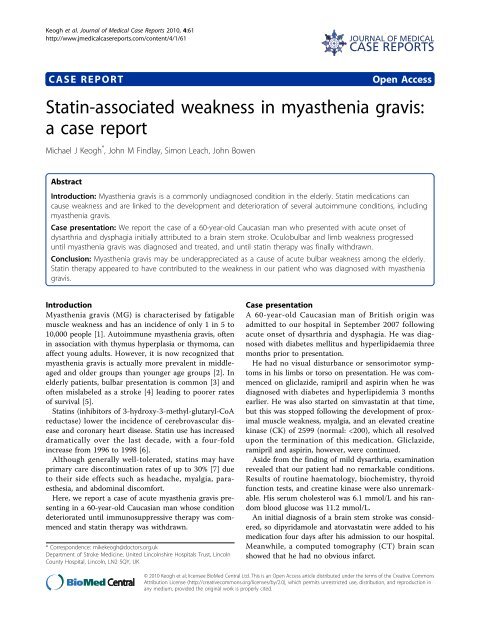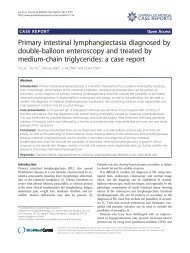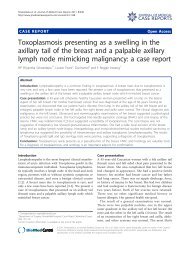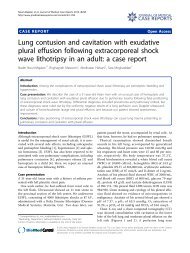Statin-associated weakness in myasthenia gravis: a case report
Statin-associated weakness in myasthenia gravis: a case report
Statin-associated weakness in myasthenia gravis: a case report
You also want an ePaper? Increase the reach of your titles
YUMPU automatically turns print PDFs into web optimized ePapers that Google loves.
Keogh et al. Journal of Medical Case Reports 2010, 4:61<br />
http://www.jmedical<strong>case</strong><strong>report</strong>s.com/content/4/1/61<br />
JOURNAL OF MEDICAL<br />
CASE REPORTS<br />
CASE REPORT<br />
Open Access<br />
<strong>Stat<strong>in</strong></strong>-<strong>associated</strong> <strong>weakness</strong> <strong>in</strong> <strong>myasthenia</strong> <strong>gravis</strong>:<br />
a <strong>case</strong> <strong>report</strong><br />
Michael J Keogh * , John M F<strong>in</strong>dlay, Simon Leach, John Bowen<br />
Abstract<br />
Introduction: Myasthenia <strong>gravis</strong> is a commonly undiagnosed condition <strong>in</strong> the elderly. <strong>Stat<strong>in</strong></strong> medications can<br />
cause <strong>weakness</strong> and are l<strong>in</strong>ked to the development and deterioration of several autoimmune conditions, <strong>in</strong>clud<strong>in</strong>g<br />
<strong>myasthenia</strong> <strong>gravis</strong>.<br />
Case presentation: We <strong>report</strong> the <strong>case</strong> of a 60-year-old Caucasian man who presented with acute onset of<br />
dysarthria and dysphagia <strong>in</strong>itially attributed to a bra<strong>in</strong> stem stroke. Oculobulbar and limb <strong>weakness</strong> progressed<br />
until <strong>myasthenia</strong> <strong>gravis</strong> was diagnosed and treated, and until stat<strong>in</strong> therapy was f<strong>in</strong>ally withdrawn.<br />
Conclusion: Myasthenia <strong>gravis</strong> may be underappreciated as a cause of acute bulbar <strong>weakness</strong> among the elderly.<br />
<strong>Stat<strong>in</strong></strong> therapy appeared to have contributed to the <strong>weakness</strong> <strong>in</strong> our patient who was diagnosed with <strong>myasthenia</strong><br />
<strong>gravis</strong>.<br />
Introduction<br />
Myasthenia <strong>gravis</strong> (MG) is characterised by fatigable<br />
muscle <strong>weakness</strong> and has an <strong>in</strong>cidence of only 1 <strong>in</strong> 5 to<br />
10,000 people [1]. Autoimmune <strong>myasthenia</strong> <strong>gravis</strong>, often<br />
<strong>in</strong> association with thymus hyperplasia or thymoma, can<br />
affect young adults. However, it is now recognized that<br />
<strong>myasthenia</strong> <strong>gravis</strong> is actually more prevalent <strong>in</strong> middleaged<br />
and older groups than younger age groups [2]. In<br />
elderly patients, bulbar presentation is common [3] and<br />
often mislabeled as a stroke [4] lead<strong>in</strong>g to poorer rates<br />
of survival [5].<br />
<strong>Stat<strong>in</strong></strong>s (<strong>in</strong>hibitors of 3-hydroxy-3-methyl-glutaryl-CoA<br />
reductase) lower the <strong>in</strong>cidence of cerebrovascular disease<br />
and coronary heart disease. <strong>Stat<strong>in</strong></strong> use has <strong>in</strong>creased<br />
dramatically over the last decade, with a four-fold<br />
<strong>in</strong>crease from 1996 to 1998 [6].<br />
Although generally well-tolerated, stat<strong>in</strong>s may have<br />
primary care discont<strong>in</strong>uation rates of up to 30% [7] due<br />
to their side effects such as headache, myalgia, paraesthesia,<br />
and abdom<strong>in</strong>al discomfort.<br />
Here, we <strong>report</strong> a <strong>case</strong> of acute <strong>myasthenia</strong> <strong>gravis</strong> present<strong>in</strong>g<br />
<strong>in</strong> a 60-year-old Caucasian man whose condition<br />
deteriorated until immunosuppressive therapy was commenced<br />
and stat<strong>in</strong> therapy was withdrawn.<br />
* Correspondence: mikekeogh@doctors.org.uk<br />
Department of Stroke Medic<strong>in</strong>e, United L<strong>in</strong>colnshire Hospitals Trust, L<strong>in</strong>coln<br />
County Hospital, L<strong>in</strong>coln, LN2 5QY, UK<br />
Case presentation<br />
A 60-year-old Caucasian man of British orig<strong>in</strong> was<br />
admitted to our hospital <strong>in</strong> September 2007 follow<strong>in</strong>g<br />
acute onset of dysarthria and dysphagia. He was diagnosed<br />
with diabetes mellitus and hyperlipidaemia three<br />
months prior to presentation.<br />
He had no visual disturbance or sensorimotor symptoms<br />
<strong>in</strong> his limbs or torso on presentation. He was commenced<br />
on gliclazide, ramipril and aspir<strong>in</strong> when he was<br />
diagnosed with diabetes and hyperlipidemia 3 months<br />
earlier. He was also started on simvastat<strong>in</strong> at that time,<br />
but this was stopped follow<strong>in</strong>g the development of proximal<br />
muscle <strong>weakness</strong>, myalgia, and an elevated creat<strong>in</strong>e<br />
k<strong>in</strong>ase (CK) of 2599 (normal:
Keogh et al. Journal of Medical Case Reports 2010, 4:61<br />
http://www.jmedical<strong>case</strong><strong>report</strong>s.com/content/4/1/61<br />
Page 2 of 4<br />
Our patient rema<strong>in</strong>ed stable over the next few days<br />
with a mild dysarthria and dysphagia (tolerat<strong>in</strong>g soft<br />
food), but no other symptoms or signs were noted.<br />
One week after his admission to our hospital, his dysarthria<br />
and dysphagia worsened. Bilateral fatigable ptosis,<br />
diplopia, fatigable <strong>weakness</strong> of his neck flexion, and<br />
shoulder abduction were noted for the first time. A previously<br />
planned cranial magnetic resonance bra<strong>in</strong> scan<br />
was thus cancelled.<br />
Edrophonium test<strong>in</strong>g demonstrated a dramatic transient<br />
improvement <strong>in</strong> his dysarthria, and a diagnosis of<br />
<strong>myasthenia</strong> <strong>gravis</strong> with high titre anti-acetylchol<strong>in</strong>e<br />
receptor antibodies was confirmed. A serum immunoglobul<strong>in</strong><br />
assay revealed an IgA level of
Keogh et al. Journal of Medical Case Reports 2010, 4:61<br />
http://www.jmedical<strong>case</strong><strong>report</strong>s.com/content/4/1/61<br />
Page 3 of 4<br />
Figure 1 This image of a graph shows creat<strong>in</strong><strong>in</strong>e k<strong>in</strong>ase read<strong>in</strong>gs dur<strong>in</strong>g admission, and a correlation to cl<strong>in</strong>ical progress.<br />
of stat<strong>in</strong> therapy [13] raises the possibility that <strong>in</strong> predisposed<br />
<strong>in</strong>dividuals, stat<strong>in</strong>s may precipitate an immunological<br />
trigger that is analogous to penicillam<strong>in</strong>e-<strong>in</strong>duced<br />
MG [15] although clearly different <strong>in</strong> temporal respect.<br />
However, given the paucity of <strong>report</strong>s and the widespread<br />
use of stat<strong>in</strong>s, the possibility of chance association<br />
cannot be excluded still.<br />
Conclusion<br />
Myasthenia <strong>gravis</strong> is a potentially fatal condition that<br />
should be considered <strong>in</strong> elderly patients with bulbar<br />
symptoms. <strong>Stat<strong>in</strong></strong> medication should be <strong>in</strong>troduced cautiously<br />
and considered as a potential cause or precipitant<br />
of worsen<strong>in</strong>g muscle strength <strong>in</strong> patients with<br />
<strong>myasthenia</strong> <strong>gravis</strong>.<br />
Consent<br />
Written <strong>in</strong>formed consent was obta<strong>in</strong>ed from the<br />
patient for publication of this <strong>case</strong> <strong>report</strong> and any<br />
accompany<strong>in</strong>g images. A copy of the written consent is<br />
available for review by the Editor-<strong>in</strong>-Chief of this<br />
journal.<br />
Abbreviations<br />
CK: creat<strong>in</strong><strong>in</strong>e k<strong>in</strong>ase; CT: computed tomography; IVIg: <strong>in</strong>travenous<br />
immunoglobul<strong>in</strong>s; MG: <strong>myasthenia</strong> <strong>gravis</strong>.<br />
Acknowledgements<br />
None<br />
Authors’ contributions<br />
MJK reviewed the patient’s cl<strong>in</strong>ical data, performed the literature search, and<br />
wrote the <strong>in</strong>itial draft of the manuscript. JMF, SL and JB reviewed the <strong>in</strong>itial<br />
draft and f<strong>in</strong>alized the manuscript. All authors read and approved the f<strong>in</strong>al<br />
manuscript.<br />
Compet<strong>in</strong>g <strong>in</strong>terests<br />
The authors declare that they have no compet<strong>in</strong>g <strong>in</strong>terests.<br />
Received: 29 January 2008<br />
Accepted: 20 February 2010 Published: 20 February 2010<br />
References<br />
1. V<strong>in</strong>cent A, Palace J, Hilton-Jones D: Myasthenia <strong>gravis</strong>. Lancet 2001,<br />
357:2122-2128.<br />
2. Slesak G, Melms A, Gerneth F, Sommer N, Weissert R, Dichgans J: Lateonset<br />
<strong>myasthenia</strong> <strong>gravis</strong>: follow-up of 113 patients diagnosed after age<br />
60. Ann NY Acad Sci 1998, 841:777-780.<br />
3. V<strong>in</strong>cent A, Clover L, Buckley V, Evans JG, Rothwell PM: Evidence of<br />
underdiagnosis of <strong>myasthenia</strong> <strong>gravis</strong> <strong>in</strong> older People. J Neurol Neurosurg<br />
Psychiatry 2003, 74:1105-1108.<br />
4. Kle<strong>in</strong>er-Fisman G, Kott HS: Myasthenia <strong>gravis</strong> mimick<strong>in</strong>g stroke <strong>in</strong> elderly<br />
patients. Mayo Cl<strong>in</strong> Proc 1998, 73:1077-1078.<br />
5. Christensen PB, Jensen TS, Tsiropoulos I, Sorensen T, Kjaer M, Hojer-<br />
Pedersen E, Rasmussen M, Lehfeldt E: Mortality and survival <strong>in</strong> <strong>myasthenia</strong><br />
<strong>gravis</strong>: a Danish population-based study. J Neurol Neurosurg Psychiatry<br />
1998, 64:78-83.<br />
6. Packham C, Pearson J, Rob<strong>in</strong>son J, Gray D: Use of stat<strong>in</strong>s <strong>in</strong> general<br />
practices, 1996-1998: a cross sectional study. BMJ 2000, 320:1583-1584.<br />
7. Simons LA, Simons J: Discont<strong>in</strong>uation rates of stat<strong>in</strong>s are high. BMJ 2000,<br />
321:1084.<br />
8. Hill M, Ben-Shlomo Y: Neurological care and risk of hospital mortality for<br />
patients with <strong>myasthenia</strong> <strong>gravis</strong> <strong>in</strong> England. J Neurol Neurosurg Psychiatry<br />
2008, 79(4):421-425.<br />
9. Prv<strong>in</strong> A, Kawasaki A, Smith K, Kestler A: <strong>Stat<strong>in</strong></strong>-<strong>associated</strong> <strong>myasthenia</strong><br />
<strong>gravis</strong>: <strong>report</strong> of 4 <strong>case</strong>s and review of the literature. Medic<strong>in</strong>e (Baltimore)<br />
2006, 85:82-85.
Keogh et al. Journal of Medical Case Reports 2010, 4:61<br />
http://www.jmedical<strong>case</strong><strong>report</strong>s.com/content/4/1/61<br />
Page 4 of 4<br />
10. Cartwright M, Jeffery D, Nuss G, Donofrio P: <strong>Stat<strong>in</strong></strong>-<strong>associated</strong> exacerbation<br />
of <strong>myasthenia</strong> <strong>gravis</strong>. Neurology 2004, 63:2188.<br />
11. Parmar B, Francis P, Ragge N: <strong>Stat<strong>in</strong></strong>s, fibrates and ocular <strong>myasthenia</strong>.<br />
Lancet 2002, 360:717.<br />
12. Khattak FH, Morris IM, Branford WA: Simvastat<strong>in</strong>-<strong>associated</strong><br />
dermatomyositis. Br J Rheumatology 1994, 33:199.<br />
13. Rudski L, Rab<strong>in</strong>ovitch M, Danoff D: Systemic immune reactions to HMG-<br />
CoA reductase <strong>in</strong>hibitors: a <strong>report</strong> of 4 <strong>case</strong>s and review of the<br />
literature. Medic<strong>in</strong>e 1998, 77:378-383.<br />
14. Ahmad S: Lovastat<strong>in</strong>-<strong>in</strong>duced lupus erthymatosus. Arch Int Med 1991,<br />
151:1667-1668.<br />
15. Wittbrodt E: Drugs and <strong>myasthenia</strong> <strong>gravis</strong>: an update. Arch Int Med 1997,<br />
157:399-408.<br />
doi:10.1186/1752-1947-4-61<br />
Cite this article as: Keogh et al.: <strong>Stat<strong>in</strong></strong>-<strong>associated</strong> <strong>weakness</strong> <strong>in</strong><br />
<strong>myasthenia</strong> <strong>gravis</strong>: a <strong>case</strong> <strong>report</strong>. Journal of Medical Case Reports 2010<br />
4:61.<br />
Submit your next manuscript to BioMed Central<br />
and take full advantage of:<br />
• Convenient onl<strong>in</strong>e submission<br />
• Thorough peer review<br />
• No space constra<strong>in</strong>ts or color figure charges<br />
• Immediate publication on acceptance<br />
• Inclusion <strong>in</strong> PubMed, CAS, Scopus and Google Scholar<br />
• Research which is freely available for redistribution<br />
Submit your manuscript at<br />
www.biomedcentral.com/submit








